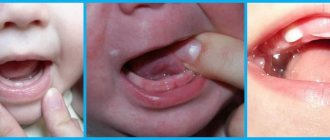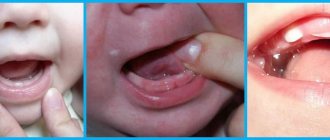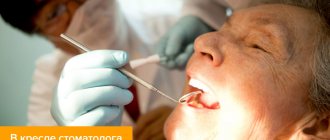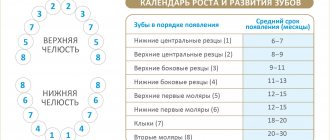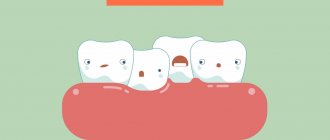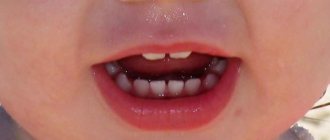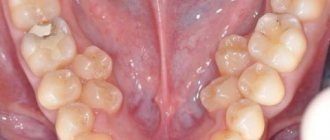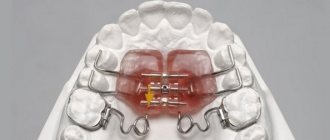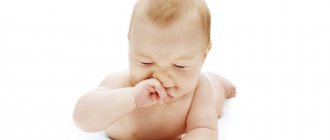It is believed that at the age of 6-7 years the first milk teeth (lower central incisors) should fall out, and at the same time the first permanent molars grow. But what if the pattern breaks down? Can the upper incisors fall out first or, for example, first the lateral and then the central incisors? What could this mean, and should parents pay special attention to this?
What if my teeth fell out too early? Or did the molars start growing before the incisors fell out? Is it normal for molars to start growing at 4-5 years of age? With what it can be connected? When should a situation alert parents?
Physiological features of the development of baby teeth
The front, or frontal, teeth are located very tightly to each other and only when the child reaches the age of four, diastemas become visible between them - physiological gaps that increase after a year or two against the background of jaw growth. If there are no diastemas at the age of six, this indicates insufficient jaw growth, leads to crowding and requires correction of the bite in children. Physiological abrasion of surfaces, which contributes to the timely development of the masticatory apparatus, begins at three years of age.
Permanent teeth appeared too early or late
It should be noted that due to the manifestation of acceleration processes, the timing of the eruption of permanent teeth has changed somewhat. Permanent teeth began to emerge earlier, at least 6-8 months. Often, already at the age of five, a child has a mixed dentition, in which the first permanent molars and central incisors are already emerging.
The timing of teething is influenced by both local and general factors.
Local:
- injury,
- premature removal of a temporary tooth,
- edentia,
- tooth retention,
- congenital clefts.
If there is no germ of a permanent replacement tooth or if its position is incorrect, there is no pressure on the bone septum separating it from the roots of the temporary tooth. This leads to a lack of activity of osteoclasts, the cells responsible for root resorption.
Are common:
- heredity,
- genetic factors
- endocrine pathology
- general health.
In particular, with diseases of the thyroid gland, as a result of an imbalance in the mineral balance in the body, there is a delay in the eruption of teeth, both temporary and permanent occlusion. Thus, with hypothyroidism, there is a delay in the eruption of milk teeth by 1-2 years, permanent teeth by 2-3 years.
In general, more and more pediatric dentists and pediatricians are noticing significant differences in the timing and sequence of teeth eruption of temporary and permanent dentition in children. Teething is a multifactorial process. The timing of teething is influenced by race and the general health of the body. None of the currently existing theories fully provides an answer to the mechanisms of teething.
Indisputable, according to many domestic and foreign pediatric dentists, is the fact that the eruption of both temporary and permanent teeth in today’s generation of children occurs earlier than average by at least 6-8 months.
Regular dental checkups will help you avoid serious dental problems.
The pediatric dentist and orthodontist closely monitor the development of the child’s dental system, providing timely assistance if necessary. March 19, 2022
Anatomy of different types of temporary teeth
- Incisors.
- Fangs.
- Molars.
Eight temporary incisors have the same structure - a fairly flat crown and 1 root. The incisors of the upper dentition, like the rest of the teeth, are larger than the lower ones. In the center, the incisors have one canal, and in 93% of cases, the lateral ones have two.
The four temporary canines are distinguished by a slightly sharp crown on all sides and the longest root. The crown of the canine preceding the permanent one is shorter and convex. The root has a rounded shape in cross-section and a slightly curved apex towards the buccal direction.
Each of the eight teeth of this type has a multi-cusped chewing surface and ends in several root canals. These are the largest teeth in childhood. The second molars are always larger than the first, which cannot be said about similar molars.
What are the anatomical features of “children’s” molars?
- The first upper molars are smaller in size than the second ones. The first has two widely spaced roots, which sometimes merge to the apex. The rudiment of the first “adult” premolar is formed between the roots. Most often, the first upper molars have four root canals, although there are also three or two (in 19 and 5% of cases, respectively).
- The first lower molars differ from others by having an elongated prismatic crown. On their chewing surface there are four tubercles: lingual, higher, and buccal. The first “children’s” molar has 2 roots, with the medial one being longer and wider than the distal one. Often the first lower molars have three canals.
- The structure of the crown of the second upper molars of the dentition resembles the first upper permanent tooth. Four tubercles are clearly visible on the surface, and sometimes a fifth one is noticeable. The buccal surface is almost square with slightly convex sides. An enamel ridge is often visible on the palatal side. Such teeth have three roots, in 85% of cases there are 4 root canals, much less often - 3.
- The second lower molars already have five cusps with less deep grooves than those of “adult” teeth. Both roots are flattened and curved at the top. In 85% of cases, teeth have three canals, although there are exceptions.
With the eruption of permanent, “adult” molars, the change of teeth begins, which lasts from 5-7 to 12-14 years. It is the first molars, which do not have primary analogues, that hold the bite, ensuring the correct placement of the remaining permanent teeth in the arch.
Timing of teething in children
Teething is physiological and serves as an indirect indicator of the correct or impaired development of the child. As a physiological act, teething is not a painful phenomenon and cannot cause any diseases. It is in direct connection with the general health of the child - timely growth of teeth in a certain sequence indicates the normal development of his body. A delay in teething may be a consequence of rickets, an infectious disease, prolonged dysfunction of the intestines and changes in metabolism. Earlier teething - endocrine disorders. A discrepancy in the time of the beginning of the eruption of the central incisors by 1-2 months from the conditional period cannot be considered as the effect of any pathology.
The newborn does not have a single tooth, although in rare cases their intrauterine development is observed. Between 6 and 8 months of life, the central incisors of the lower jaw begin to appear, and then the upper. By 8-12 months, the lateral incisors are formed first on the lower jaw and then on the upper jaw. By 12-16 months, the first molars erupt, by 16-20 months - the canines, and by 20-30 months - the second molars, which complete the formation of the primary bite.
The eruption of baby teeth often affects the child’s well-being. In weakened children, this physiological process is accompanied by general malaise, poor sleep, restless behavior, crying, and moodiness. Sometimes the temperature rises to 37.50C, the nature of bowel movements changes, short-term rashes on the body and redness of the facial skin are possible. The child's weight gain is temporarily suspended and immune defense is reduced. To establish the true cause of the malaise, a consultation with a pediatrician is necessary.
At the 7th year of life, the replacement of baby teeth with permanent ones occurs, the time of eruption of which, as a rule, coincides with the resorption of the roots of baby teeth and their loss. In contrast, the formation of a permanent bite begins with the appearance of the first molars of the lower jaw and normally ends by 15-18 years. The central incisors (8-9 years), first premolars (9-10 years), canines (10-11 years), second premolars (11-12 years), second molars (12-13 years) sequentially erupt. The third molars of the lower jaw, or as they are sometimes called “wisdom” teeth, grow later, often after the age of 20-25 years.
A correctly and timely formed bite plays a big role in the normal development of the child’s body. Violation of the timing of teething (early or late), the order, as well as the absence of one or another tooth require the attention of a pediatrician and dentist, since they are evidence of pathology not only of a local, but often of a general nature (the result of diseases suffered by the mother during pregnancy, or any anomalies in the child’s health).
For various reasons, a number of deviations can occur in the structure of teeth, their location and development: the absence of a rudiment of a tooth, an incorrect position of the tooth axis (horizontal or oblique), which is why it erupts outside the arch of the dentition or remains in the thickness of the jaw bone. In addition, the incorrect formation of the tooth itself - size, shape, position, color, lack of enamel coating, etc. Such changes should be analyzed by a specialist.
Timing of teeth eruption, formation of rudiments and roots, maturation of enamel
Baby teeth
| Teeth | Period of eruption, months. | Timing of root formation | Beginning of root resorption | Root resorption time |
| I | 6 — 8 | +2 years | from 5th year | in current 2 years |
| II | 8 — 12 | +2 years | from 6th year | in current 2 years |
| III | 16 — 20 | +3 years | from 8th year | in current 3 years |
| II | 8 — 12 | +2 years | from 6th year | in current 2 years |
| V | 20 — 30 | +3 years | from 7th year | in current 3 years |
Permanent teeth
| Teeth | Timing of eruption | Timing of root formation | Final “enamel maturation” | Bookmark of follicles |
| 6 | 5 — 6 | at 10 | at 1 - 3 years | at 5 months intrauterine development |
| 1 | 6 — 8 | at 10 | at 4 -5 years old | at 8 months high-quality development |
| 2 | 8 — 9 | at 10 | at 4 -5 years old | at 8 months high-quality development |
| 4 | 9 — 10 | at 12 years old | at 5-6 years old | at 2 years old |
| 3 | 10 — 11 | at 13 years old | at 6 -7 years old | at 8 months high-quality development |
| 5 | 11 — 12 | at 12 years old | at 6 -7 years old | at 3 years old |
| 7 | 12 — 13 | at the age of 15 | at 7-8 years old | at 3 years old |
For infants, the number of teeth that have erupted is one of the objective criteria by which the baby’s health status is assessed. The timing of teething and the order of their appearance can vary significantly. So, the first tooth can appear as early as 1 month or 1 year, but most often this happens at 6-8 months of life. To calculate the number of baby teeth (N), depending on age, use the formula: N = n-4, where n is the number of months of a child’s life. So, at the age of 12 months, the baby should have 8 teeth.
Signs of physiological teething
- Teething at certain average times
- Eruption pairing
- Teething in a specific order
Causes of delayed teething:
- rickets and other disorders of calcium-phosphorus metabolism;
- decreased activity of the endocrine glands (hypothyroidism);
- disturbances in the digestion and absorption of nutrients;
- severe eating disorders;
- chronic infections;
- hereditary disorders of mineral metabolism and diseases of osteochondral tissue;
Difficult teething with increased body temperature, catarrhal symptoms, and indigestion is most often caused by an infectious disease. Therefore, the appearance of such symptoms in a baby during teething requires a mandatory medical examination and observation!
Possible features of teeth in children at the teething stage:
- Expansion of spaces between teeth. It may reflect increased jaw growth and during the transition period from baby teeth to permanent teeth is regarded as a normal condition. A wide gap between the front incisors on the upper jaw is usually associated with a deep-lying maxillary frenulum. The tactics for monitoring and treating wide gaps between teeth are determined by an orthodontist.
- A blackish edging on the neck of the tooth can be due to the use of soluble iron preparations or a chronic inflammatory process (precipitation of bacteria of the leptotrichium group);
- Yellowish-brown staining of teeth is most often associated with the use of antibiotics by the mother in the second half of pregnancy or by the child during the period of teeth formation.
- A yellowish-greenish color develops in severe disorders of bilirubin metabolism and hemolytic (destruction of red blood cells) conditions;
- Reddish staining of tooth enamel is characteristic of a congenital disorder of pigment metabolism - porphyrin. This disease is called porphyria;
- Malocclusions occur due to uneven growth of the jaws, due to prolonged sucking of the nipple;
- Anomalies in the location of teeth occur for constitutional reasons (small jaw size), due to trauma, congenital disorders of connective tissue metabolism, and tumors of the alveolar process of the jaw.
The absence of teeth before 1 year of age is extremely rarely associated with edentia - the absence of their rudiments. You can check the presence of tooth germs using a special radiovisiography method prescribed by a pediatric dentist.

